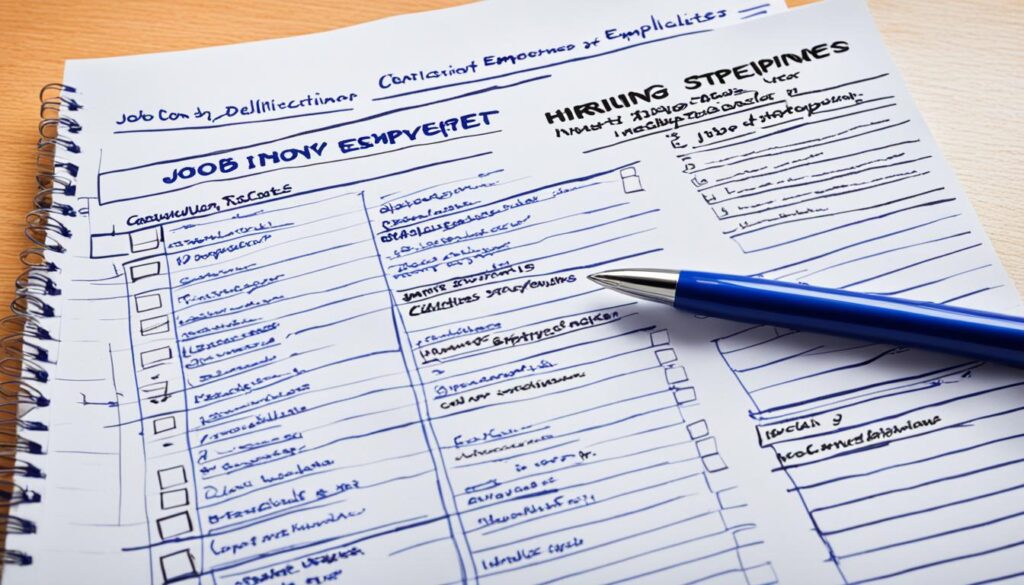Did you know that since the year 2000, the number of part-time positions in the U.S. has surged by an astonishing 18%? This growing trend, intensified by economic shifts such as the Great Recession, shows the ever-increasing relevance of part-time employment in today’s job market. As an employer, you’re positioned at the heart of this evolution, tasked with the pivotal role of shaping a resilient and dynamic hourly workforce. To navigate this changing landscape and successfully hire hourly employees, there are key strategies you need to master, from crafting effective hourly job postings to creating a streamlined hourly hiring process.
Whether you’re looking to find hourly employees for retail, hospitality, or any sector where flexibility is key, it’s imperative to provide an experience that resonates with what the modern hourly worker seeks. To attract and retain top talent, you must offer more than just a paycheck – a promise of a healthy work-life balance, clear communication, and growth opportunities is critical. In this article, we’ll walk you through the steps and insights necessary to hire part-time staff effectively, ensuring you have access to cost-effective hourly workforce solutions that support both your business objectives and your employees’ aspirations.
Key Takeaways
- Understanding the landscape of part-time employment is crucial for tailoring your hiring strategy.
- Get your new hire paperwork in order with forms like Form W-4 and Form W-2 to avoid any legal setbacks.
- Clearly define your open positions and use wide-reaching advertising tactics, including social media and job fairs, for effective job postings.
- Streamline your screening processes to quickly identify the most suitable candidates for your team.
- Recognize the importance of onboarding and retention strategies for maintaining a strong hourly workforce and reducing turnover costs.
Understanding the Hiring Landscape for Hourly Employees
As you navigate the complexities of the hiring environment, it’s essential to grasp the nuances of the hiring landscape that characterize today’s market. Amidst rising demand for hourly work, employers must reconcile their approaches with the ever-shifting dynamics of key industries. The prevalence of part-time jobs has been particularly evident in sectors such as retail, hospitality, and manual labor—industries that significantly rely on an hourly hiring model.
In an era marked by significant economic changes, employers are tasked with adapting their hiring strategies to remain competitive. With an understanding that nearly half of hourly workers are contemplating job changes, according to SHRM’s survey, it’s clear that the stakes for securing reliable talent are high.
The Rise of Hourly Work in Key Industries
The landscape of hourly employment has seen notable shifts, with job search efforts rising amongst the young workforce. Statistics reveal a stark reality—67 percent of hourly workers live on a household income below the national median, underscoring the critical nature of hourly work as a lifeline for many families. Simultaneously, the median hourly wage has shown only a modest increase over two decades, with rates moving from $21.90 in 2002 to $22.88 in 2022 when adjusting for inflation.
Adapting to Economic Changes and their Impact on Hourly Hiring
The ripple effects of economic fluctuations are felt distinctly in the realm of hourly employment. A notable 73 percent of hourly workers express that they would remain with their current employer in the event of a wage increase. And yet, 28 percent would consider staying for a raise of less than 5 percent. As employers, understanding these metrics is not just about numbers but about the human element—90 percent of hourly workers assert the importance of feeling valued in the workplace.
Assessing the High Turnover Rates Among Hourly Workers
Turnover rates in hourly roles are a pressing concern, amplified by the evolving expectations of the workforce where younger employees, Gen Z and younger Millennials, are 60 percent more likely to seek new job opportunities compared to their older counterparts. By 2025, Millennials and Generation Zers are projected to comprise 75 percent of the global workforce, shaping the future of hourly hiring practices and the importance of appealing work schedules, which 51 percent of workers consider crucial for job satisfaction.
The Initial Steps Before You Hire Hourly Employees
Before you dive into the search for your next hourly team member, there are essential initial steps that set the foundation for a lawful and smooth hiring process. As an employer, it’s imperative to ensure that all legal and administrative bases are covered before you hire hourly employees. Let’s go step by step through what you need to get in place.
- Legal Employment Documentation: All U.S. employers are required to complete Form I-9 for every individual hired. This form verifies an employee’s identity and their authorization to work in the United States. Make sure both you and your employees complete this form to stay compliant with employment laws.
- Social Security Number Confirmation: You will need your employees’ names and Social Security numbers (SSN) for tax reporting on Form W-2. The Social Security Administration provides a verification service, which is an essential tool for confirming your employees’ SSNs quickly and accurately.
- Employee’s Withholding Certificate: A Form W-4, or Employee’s Withholding Certificate, must be provided by each employee to establish income tax withholding amounts. Ensure you receive a signed Form W-4 from your employees when they start work, as withholding will be based on the information they provide.
- Compliance with Wage Laws: Understand and comply with the Fair Labor Standards Act (FLSA) that stipulates a minimum wage of $7.25 per hour and overtime pay requirements. Special wage considerations apply to tipped employees and workers under 20 years of age.
- Workers’ Compensation Insurance: Most businesses are required to have Workers’ Compensation insurance to provide coverage for on-the-job injuries or illnesses. Check your state’s specific laws to confirm your obligations.
- New Hire Reporting: Report each new employee to your state’s new hire reporting agency. This system aids in child support enforcement and may differ slightly from state to state.
- Safety and Health Compliance: Adhere to OSHA standards by maintaining detailed safety records, conducting employee safety training, and ensuring a hazard-free workplace.
- Personnel File Management: Create and keep updated personnel files for each employee, including job applications, performance evaluations, and tax forms such as IRS Form W-4.
- Benefits Program Administration: If you offer benefits like health insurance or retirement plans, ensure that you have a structured enrollment process for your employees to join and manage their benefits.
By following these initial steps, you will not only hire hourly employees within the bounds of the law but also foster an organized and transparent workplace from the outset. Now that we’ve covered the preparatory groundwork, let’s ensure your hiring practices are up to the same standard.

Effective Strategies to Recruit Hourly Workers
With hourly employee turnover rates soaring between 70 to 120 percent annually across most industries, employers must leverage innovative strategies to recruit hourly workers efficiently. Understanding the demographic of hourly employees, where the majority are under the age of 44 and prefer working near home, can guide your recruitment tactics.
Capitalizing on Digital Recruitment Tools
Embrace the power of digital recruitment tools to streamline your hiring process. By employing online job boards and applicant tracking systems, you can instantly connect with an extensive pool of candidates. Considering that most hourly workers apply for three jobs simultaneously and prefer a swift hiring process, these tools can help you act quickly and efficiently, improving your chances of securing top talent.
Leveraging Social Media for Wider Reach
Expand your recruiting reach through strategic use of social media channels. Although only 6% of companies focus on platforms like LinkedIn, incorporating networks like Twitter and TikTok into your recruitment efforts can expose your job postings to a demographic that values full-time careers and competitive pay. Interactive content can bolster community engagement and attract candidates looking for roles that align with their career goals and work-life balance.
Localizing Job Postings for Community Engagement
Focus on community engagement by localizing your job postings. Most hourly workers prefer jobs within a 5-mile radius of their homes, emphasizing the importance of attracting local talent. Tailored job postings that highlight proximity to home, benefits such as tuition and loan assistance, and flexible work schedules can be attractive to potential applicants seeking convenience and work-life balance.
- Benefits like performance bonuses, referral programs, and paid time off are proven to attract and retain employees within the hourly sector.
- Employers are advised to be transparent about career development opportunities to mitigate the risk of workers leaving for just a tiny increase in wages elsewhere.
- Providing flexible work schedules and investing in tools that facilitate better communication can significantly reduce the high turnover rate seen in industries reliant on hourly workers.
Your hiring strategies can be further enhanced by understanding that while 90% of employers value resumes, a considerable number of hourly workers prioritize quick hiring processes and pay. This insight, combined with robust recruitment practices, can help you recruit and retain a dedicated workforce.
The Pivotal Hourly Hiring Process from Posting to Interview
Embarking on the hourly hiring process is a significant step towards cultivating your team. With candidates seeking immediacy in applications, flexibility becomes key in addressing their need for promptness—from job posting to the crucial interview stage.

Your job posting should reflect the urgency and simplicity desired by potential applicants. With more than 100,000 locations benefitting from TalentReef’s services, a proven strategy is tailoring postings to fit various industries, whether it’s quick-serve restaurants or convenience stores.
After attracting suitable candidates, the next challenge is screening—a process TalentReef has enhanced by automating elements like background checks and incorporating a system that updates payroll information seamlessly, prioritizing the candidate’s experience.
- Post your job with clear, flexible options allowing candidates to engage with multiple channels.
- Automate screening procedures to quickly identify qualified applicants.
- Conduct interviews with a focus on both technical skills and cultural compatibility.
Hourly workers are undeniable revenue generators in industries like entertainment and service businesses. Hence, you want an hiring system that adapts dynamically to your business needs—be it for seasonal trends or immediate hires.
The final objective is a frictionless candidate journey, which TalentReef achieves through innovative software solutions, ultimately ensuring a smooth transition from candidate attraction to the decisive interview.
How to Hire Hourly Employees: A Streamlined Application Experience
With the number of U.S. job openings hitting 10 million, predominantly in hourly fields like retail and warehousing, the need to hire hourly employees has become more pressing than ever. A significant challenge employers face is the high turnover rate, with nearly a quarter experiencing over 30% turnover. Thus, creating a streamlined application experience is not just beneficial, it’s essential for attracting and retaining quality staff.
Creating Mobile-Friendly and Quick Application Processes
To stay competitive in the marketplace, your application process must be quick and mobile-friendly. With 80 to 90% of hourly and frontline workers seeking jobs through mobile devices, your company can capitalize on this trend by providing an application experience that can be completed swiftly on the go. This not only increases the number of applicants but also caters to the tech-savvy workforce that expects efficiency and convenience.
The Importance of Swift Communication with Candidates
After candidates apply, maintaining swift communication is paramount. In a space where 62% of employers make hiring decisions based on in-person interviews, it’s crucial to engage with candidates quickly to schedule these interviews. Fast and clear communication ensures you keep talented prospects interested and conveys your company’s commitment to an attentive hiring process.
Implementing Pre-Employment Assessments to Gauge Skills
Incorporating pre-employment assessments into the hiring process can greatly improve your selection method. While 90% of employers still consider resumes important, these assessments provide a more hands-on evaluation of a candidate’s abilities, relevant to their daily tasks. This approach is consistent for both hourly and salaried positions, as 70% of employers use the same hiring process for different employment types.
- Understand that a significant percentage of hourly roles are filled through traditional channels, yet modernizing the application to be mobile-responsive can greatly boost candidate inflow.
- Given the select few, only 6%, sourcing through platforms like LinkedIn, it might be beneficial to diversify sourcing strategies to include more direct, mobile-friendly avenues.
- Lastly, Advocate Behr highlights, simplifying your application process—by quickly responding to applications—goes a long way in securing top hourly talent.
Retention Strategies for Your Hourly Workforce
Once you’ve welcomed hourly employees into your fold, your focus must shift towards retention strategies to ensure they remain a part of your team. A startling 95% of businesses are paying above the federal minimum wage, reflecting the shift towards more competitive compensation approaches. However, it’s not solely about the paycheck. The hourly workforce looks for a holistic package that includes benefits and perks that cater to their needs and aspirations. For instance, Amazon’s bold move to offer full college tuition for hourly workers is an excellent example of a company tailoring benefits to enhance their employee value proposition.
In the same vein, employers are creatively augmenting their retention strategies by introducing elements such as retirement account contributions, healthcare benefits, and immediate eligibility for healthcare—benefits typically reserved for salaried positions. Yet even more are going further, integrating lifestyle benefits like flexible working hours, backup childcare, and paid time off for national holidays into the mix. With over 40% of organizations considering sign-on bonuses, the competition for retaining skilled workers is intense, indicating that retention bonuses and increased shift premiums may soon become standard offerings in a quest to sustain a dedicated hourly workforce.
Ultimately, fostering a stable and committed hourly workforce necessitates a commitment to listening and responding to their needs. Employers who host forums and surveys, collating feedback similar to the insights found in the digital focus group by Mercer, are better positioned to create a compelling employee value proposition. Your retention strategies, from competitive wages to comprehensive benefits, are paramount in building a lasting relationship with your hourly employees, ensuring they feel valued and integral to your company’s success. Understand their priorities, offer support, and you’ll not only retain but also inspire loyalty within your workforce.
FAQ
How can I hire hourly employees efficiently?
What are some effective recruitment strategies for hiring hourly workers?
What steps are involved in the hourly hiring process?
How can I create a streamlined application experience for hourly employees?
What are effective retention strategies for hourly employees?
Author
-

Sophia Alvarez brings extensive knowledge in employee management and strategic hiring practices. With over 15 years in HR, she has pioneered innovative approaches to talent acquisition and workforce planning.
View all posts



